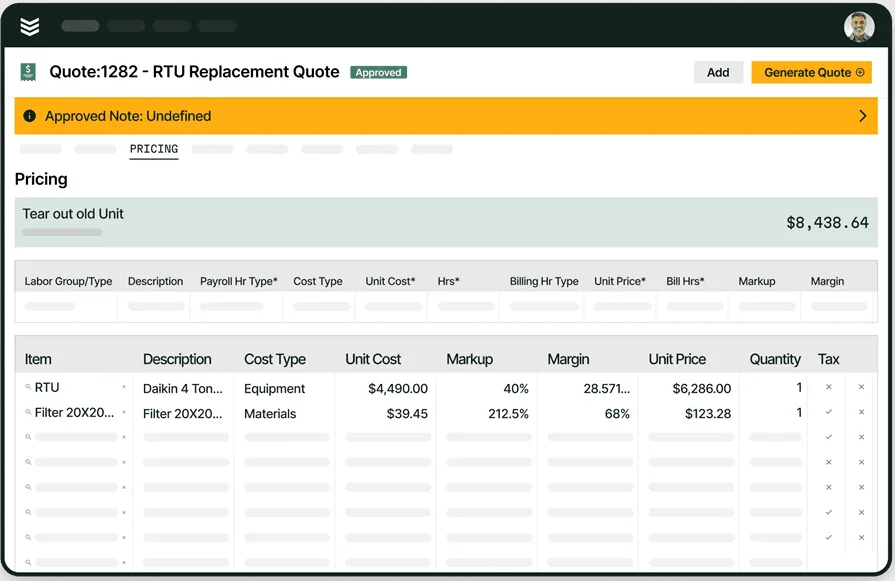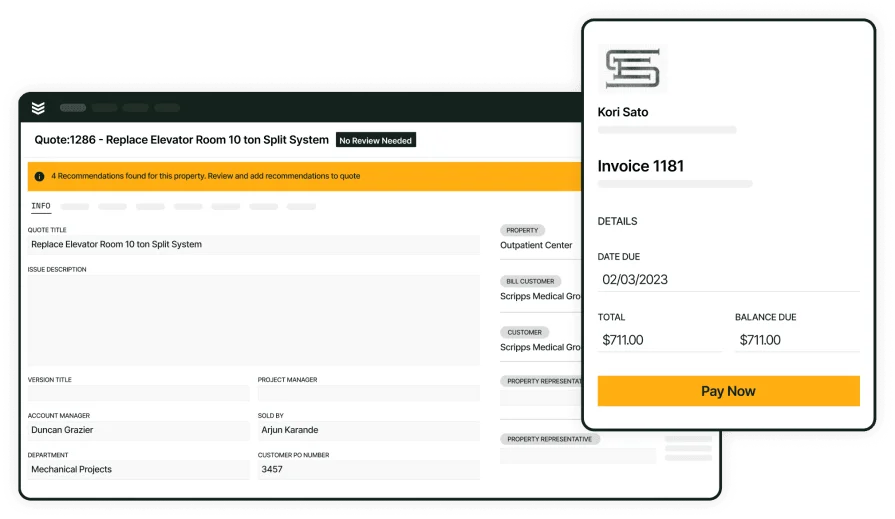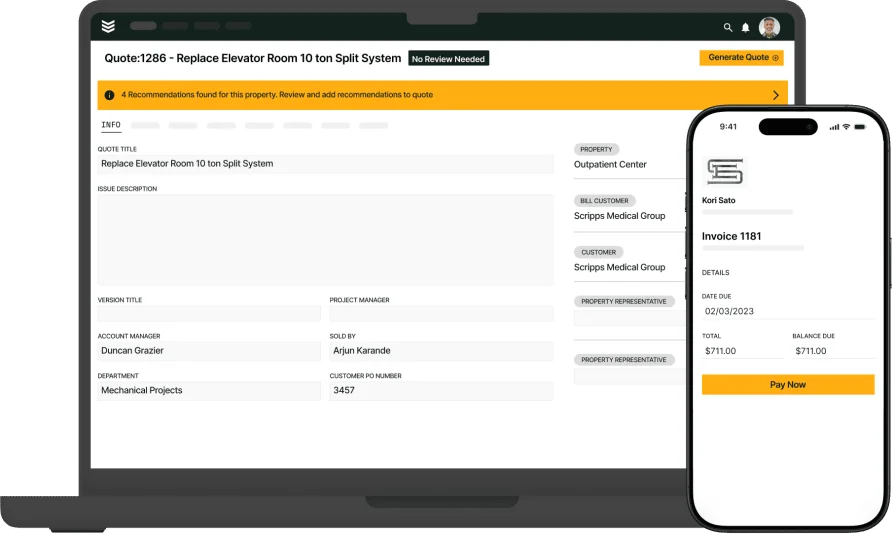If you’re in the HVAC industry, winning more leads starts with good software. If your numbers are off, you risk losing bids—or worse, losing money on jobs you win. Manual estimating leaves too much room for mistakes, and clunky spreadsheets slow everything down.
That’s where HVAC estimating software comes in. The right tool helps you calculate labor, materials, overhead, and profit margins with precision. It speeds up the bidding process, eliminates guesswork, and gives your business a competitive edge.
Whether you're pricing a small residential install or a large commercial contract, HVAC estimating software ensures your quotes are fast, professional, and profitable. To help you decide which software is best for you, here’s what we’ll cover:
- Choosing the right HVAC estimating software for your needs
- 6 key features to look for in HVAC estimating software
- 7 best HVAC estimating software for all contractor types
- 7 benefits of using estimating software for HVAC
- 5 important HVAC estimator software FAQs answered
Not all HVAC estimating software is built the same. The right choice depends on your business size, the type of jobs you take on, and how detailed your estimates need to be. Before diving into key features, let’s look at what to consider when choosing the best estimating tool for your needs.
Choosing the right HVAC estimating software for your needs
The right tool should fit your workflow, speed up the bidding process, and ensure accuracy in every quote. Before committing to a platform, consider these key factors:
- Ease of use – Can your team create estimates quickly without extensive training? Look for software with an intuitive interface, drag-and-drop functionality, and pre-built templates that simplify the estimating process.
- Custom pricing & labor rates – Does the software allow you to adjust labor rates, materials, and markups to match your pricing model? The best tools provide real-time supplier pricing updates and customizable cost databases.
- Integration with other tools – Will the software connect seamlessly with your accounting, job management, and field service platforms? Integration ensures estimates flow directly into work orders and invoices without manual entry.
- Cloud-based & mobile access – Can you create and edit estimates from anywhere? A cloud-based platform lets you update quotes in real-time, whether you're in the office or on-site, ensuring faster approvals and fewer delays.
- Essential features – Does the estimating software for HVAC include automated calculations, pre-built templates, and reporting tools? A strong feature set helps you generate professional, accurate estimates while reducing errors.
Choosing the right HVAC service estimating software is about efficiency, accuracy, and scalability. Let’s break down the key features that separate the best tools from the rest.
6 key features to look for in HVAC service estimating software
Getting an estimate wrong can cost you thousands—either by overbidding and losing the job or underbidding and losing profit. HVAC contractors juggle material costs, labor rates, and unexpected job-site challenges, all while racing against the clock to get accurate bids out the door. That’s why HVAC estimating software isn’t just a convenience—it’s a necessity.
Let’s break down the six key features that help HVAC businesses bid smarter, work faster, and win more jobs.
1. Automated cost calculation
Manually crunching numbers leaves too much room for error. HVAC estimating software automatically calculates costs based on labor, materials, overhead, and profit margins, ensuring every estimate is precise. With built-in formulas and price databases, you can adjust markups, apply discounts, and generate estimates without second-guessing your math.
Take this scenario: Your techs just completed a job site evaluation for a large commercial HVAC retrofit. Instead of wasting hours tallying up ductwork, fittings, and labor hours, you use HVAC estimating software with real-time cost tracking to generate a professional, error-free estimate in minutes. No manual entry, no missed line items—just a clean, accurate quote ready for approval.

Explore our estimating product
Create faster, more accurate estimates—while eliminating costly mistakes.
2. Customizable labor and material pricing
No two HVAC jobs are the same, and your estimating software should reflect that. The best platforms let you customize labor rates based on experience level, job complexity, and location while also allowing for real-time material cost adjustments. This flexibility ensures you’re pricing jobs accurately without relying on outdated spreadsheets.
Think about a service manager preparing bids for a high-end residential HVAC installation and a quick filter replacement. Both require different pricing models. With HVAC estimating software that updates material costs dynamically, the system pulls current supplier pricing, preventing underquoting and ensuring every job stays profitable.
3. Integration with job management tools
A great estimate is only useful if it seamlessly transitions into the rest of your workflow. HVAC estimating software should integrate with scheduling, invoicing, and dispatching tools, so you don’t have to re-enter data manually. This eliminates errors and speeds up job execution from estimate to completion.
Imagine a technician who just landed a signed estimate for a rooftop unit replacement. Instead of re-entering job details, HVAC estimating software that connects with scheduling tools automatically generates a work order and assigns a crew. Now, techs know exactly what’s needed, and there’s no risk of missing critical job details.
4. Pre-built and customizable templates
Speed matters when sending out estimates, and using pre-built templates cuts down on manual work while ensuring consistency. The best HVAC estimating software includes templates tailored to different job types, from new installations to emergency repairs, with customizable fields for company branding, terms, and scope of work.
When an HVAC business frequently bids on commercial maintenance contracts, instead of writing proposals from scratch each time, they rely on HVAC estimating templates built for commercial projects to generate detailed, professional quotes in minutes. This not only saves time but also creates a polished, consistent brand image.
5. Mobile and cloud-based access
Field techs and sales teams aren’t tied to a desk, so estimating software shouldn’t be either. Cloud-based platforms allow teams to create, modify, and send estimates from any device, whether they’re at a job site or meeting with a client. Mobile access means faster approvals and a smoother sales process.
For example, a tech inspecting an aging HVAC system at a client’s facility can pull out their tablet, input job details, and generate an HVAC estimate directly from a mobile app. The client sees the quote instantly, approves it on-site, and work can begin without any delays.
6. Automated estimate-to-invoice conversion
Closing the deal is just the beginning—once the work is done, turning estimates into invoices should be seamless. The best HVAC estimating software links directly to invoicing tools, ensuring that all labor, materials, and additional charges are accounted for without extra data entry.
When an HVAC contractor is busy wrapping up a commercial chiller installation, instead of manually building an invoice from scratch, HVAC estimating software that syncs with invoicing systems pulls the estimate details, adjusts for any change orders, and generates a ready-to-send invoice—ensuring faster payments and fewer billing disputes.
Choosing software with these six features ensures your HVAC business can create faster, more accurate estimates while eliminating costly mistakes. Next, we’ll explore the best HVAC estimating software for different types of contractors.
Other valuable features for HVAC service companies
Beyond estimating, the best HVAC software solutions include additional features that streamline operations and improve efficiency. These tools help contractors manage jobs, track technicians, and keep their business running smoothly. Here are a few valuable features to look for:
- Fleet tracking and management – Keeping track of company vehicles is critical for ensuring techs arrive on time and job costs stay under control. With fleet management software for HVAC businesses, contractors can monitor vehicle locations, optimize routes, and reduce fuel costs.
- Service agreements and contract management – Recurring maintenance contracts keep revenue steady and customers happy. HVAC service agreement software automates contract tracking, renewals, and invoicing, helping businesses maintain strong client relationships.
- Automated payment processing – A seamless payment system speeds up cash flow and reduces administrative tasks. HVAC payment processing tools allow customers to pay invoices instantly through credit cards, ACH transfers, or mobile payment options.
With the right combination of estimating and operational tools, HVAC contractors can improve efficiency, reduce costs, and provide better service to their customers. Next, we'll explore the top benefits of using estimating software for HVAC.
7 best HVAC estimating software for all contractor types
For contractors to get the most value out of their HVAC estimating software, they need to choose the right fit for their needs. It comes down to finding a solution that delivers the features you want and empowers your team to deliver better results. Below, we compare the top HVAC estimating solutions.
1. Best for commercial contractors: BuildOps
BuildOps is designed with commercial HVAC contractors in mind, offering a powerful suite of tools to simplify estimating and bidding on large-scale projects. It streamlines the process from cost calculations to final proposals, ensuring estimates are accurate and competitive. With seamless integrations, BuildOps keeps everything from estimating to invoicing in one centralized system.
How pricing works: BuildOps follows a customized pricing model based on business size and requirements. This ensures you’re only paying for the features that directly impact your estimating and bidding process.
Features beyond estimating:
- Real-time cost tracking and job costing
- Automated labor and material calculations
- Seamless integration with scheduling and invoicing
What sets it apart for commercial: BuildOps stands out by tailoring its estimating software to the unique needs of commercial contractors. BuildOps streamlines the estimation process for large, complex projects through automated takeoff tools, real-time cost tracking, and seamless integrations.

Explore our estimating tools
See how we streamline estimating and bidding so you land more jobs.
2. Best for residential contractors: Housecall Pro
Image Source: Housecall Pro
Housecall Pro is a great choice for residential HVAC contractors, offering easy-to-use tools for estimating, scheduling, and client communication. Its intuitive interface allows small teams to generate and send estimates quickly, ensuring homeowners receive accurate quotes without delay. While it excels in residential HVAC estimating and job management, it may not be the ideal solution for contractors handling large-scale commercial projects. Its features are geared toward smaller teams, and it lacks the advanced cost-tracking and integration capabilities required for complex, multi-phase jobs.
How pricing works: Housecall Pro offers tiered pricing plans, allowing businesses to choose a package that best aligns with their size and operational needs.
Features beyond estimating:
- Built-in scheduling and dispatching tools
- CRM features for customer relationship management
- Mobile app for on-the-go estimate creation
What sets it apart for residential: Housecall Pro is built with residential contractors in mind, focusing on simplicity and efficiency. Its all-in-one platform allows HVAC businesses to send estimates, manage customers, and schedule jobs seamlessly—all from a mobile device.
3. Best for general contractors: Jobber
Image Source: Jobber
Jobber is designed for general contractors who need a flexible estimating platform that works across a variety of HVAC project types. With its simple layout, users can easily create quotes, track time, and manage estimates all in one place. Although it offers a flexible estimating platform for general contractors, it may not be the best fit for businesses that require deep customization or advanced reporting. Its simplicity makes it great for smaller operations, but larger HVAC firms may find its job tracking and estimating features too basic for managing high-volume projects.
How pricing works: Jobber offers three pricing tiers tailored to different needs, giving contractors the flexibility to choose the plan that best fits their business.
Features beyond estimating:
- Quick and accurate quote creation
- Real-time job tracking and task management
- A mobile app for field and office synchronization
What sets it apart for general contractors: Jobber simplifies the estimating process for general contractors by offering an intuitive platform that balances quoting, scheduling, and invoicing. Its real-time tracking tools help manage multiple projects efficiently without getting overwhelmed by administrative work.
4. Best for large-scale projects: SimPRO
Image Source: Simpro
SimPRO offers advanced job costing, automated takeoffs, and detailed material tracking, making it a great fit for companies managing multiple high-value contracts. While SimPRO is a powerful estimating solution for HVAC businesses handling large projects, its complexity and steep learning curve may not be ideal for smaller contractors.
How pricing works: SimPRO follows a subscription-based pricing model, with different tiers based on company size and feature needs. Larger businesses may benefit from its comprehensive toolset, but smaller HVAC contractors may find it more than they need.
Features beyond estimating:
- Integrated inventory management to track material costs in real-time
- Automated takeoff tools for quicker and more accurate estimates
- Seamless integration with accounting and field service platforms
What sets it apart for large-scale projects: SimPRO stands out for HVAC contractors working on commercial or multi-phase projects by offering detailed job costing and material tracking, ensuring every estimate reflects real-world costs.
5. Best for quick HVAC estimates: Clear Estimates
Image Source: Clear Estimates
Clear Estimates excels in residential HVAC estimating by offering pre-built templates and customizable pricing databases, making it ideal for smaller contractors looking for a quick and easy solution. Though it is designed for contractors who need simple and fast estimate generation, it may lack the advanced features required for large-scale HVAC businesses.
How pricing works: Clear Estimates provides a low-cost, subscription-based model, making it accessible for smaller HVAC businesses. However, it does not offer extensive integrations with field service management or dispatching tools.
Features beyond estimating:
- Pre-loaded templates for HVAC service and installation quotes
- Customizable pricing databases for materials and labor
- Simple customer management tools to store past estimates
What sets it apart for quick HVAC estimates: Clear Estimates is great for contractors who need a lightweight, easy-to-use estimating tool without added complexity. However, it may not be the best fit for businesses that require deep customization or advanced reporting.
6. Best for HVAC construction: FastEST
Image Source: FastDUCT
FastEST is designed for precision estimating in large-scale construction jobs, it includes advanced takeoff tools and detailed material databases. While they are a specialized estimating tool for mechanical and HVAC contractors, its focus on commercial projects means it may not be the best fit for residential service providers.
How pricing works: FastEST operates on a one-time license fee, which can be costly upfront.
Features beyond estimating:
- Advanced takeoff functionality for ductwork and piping estimates
- Detailed cost databases with up-to-date pricing for commercial materials
- Built-in reporting for tracking bid performance
What sets it apart for commercial HVAC: FastEST is ideal for contractors who require precise material and labor estimates for large-scale HVAC construction. However, its high cost and complexity may not suit smaller service-oriented businesses.
7. Best for sales-driven HVAC teams: Estimate Rocket
Image Source: Estimate Rocket
Estimate Rocket’s strength lies in fast estimate creation and follow-ups, making it a good choice for residential and light commercial work. Although Estimate Rocket is an excellent tool for automating proposals and tracking bids, it may not be robust enough for HVAC contractors working on high-volume commercial jobs.
How pricing works: Estimate Rocket uses a monthly subscription model, offering different plans based on the number of users. While it provides strong estimating and proposal tools, it lacks deep integrations with HVAC-specific scheduling and dispatch software.
Features beyond estimating:
- Fast proposal generation with digital signature capabilities
- Automated follow-up reminders to increase bid acceptance rates
- Simple invoicing and job tracking tools for small teams
What sets it apart for sales-driven HVAC teams: Estimate Rocket works well for HVAC businesses focused on speeding up the proposal process and improving customer communication. However, it may not be the best fit for large contractors needing complex job costing features.
7 benefits of using estimating software for HVAC
Choosing the right HVAC estimating software is easier when you understand exactly what it can do for your business. From eliminating guesswork to improving profitability, the right tool helps HVAC contractors bid smarter, win more jobs, and keep projects on track.
Here’s how the best HVAC estimating software benefits commercial contractors.
1. Faster and more accurate bids
In commercial HVAC estimating software, speed matters. The longer you take to submit a bid, the greater the chance a competitor beats you to it. HVAC estimating software streamlines the process by automating calculations, adjusting labor rates, and pulling material costs in real time. This means fewer delays and HVAC estimates that are both fast and accurate—giving you an edge in competitive bidding situations.
2. Improved profitability on every job
Even small estimating mistakes can eat into your profit margins in a big way. Underpricing labor, overlooking material costs, or forgetting overhead expenses can turn a job into a loss. With the use of software to estimate for HVAC, contractors can apply consistent markup rates, track profit margins in real time, and ensure every bid covers costs while staying competitive. This way, HVAC contractors can avoid profit-draining errors and make smarter pricing decisions.
3. Standardized estimates across teams
When multiple estimators are involved, inconsistencies in pricing can lead to confusion and lost revenue. HVAC estimating software ensures every quote follows the same structure, pricing model, and formatting. Whether you're working with in-house estimators or project managers, a consistent HVAC estimate template improves professionalism and accuracy across all bids.
4. Better job planning and resource allocation
Accurate estimates don’t just help with bidding—they set the foundation for job planning. By breaking down labor, materials, and timelines, the best HVAC estimating software helps contractors allocate the right resources before work begins. This means fewer project delays, better crew scheduling, and a more efficient workflow from start to finish.
5. Reduced project overruns
Cost overruns are a major issue in commercial HVAC projects. Without a precise estimate, unexpected expenses can pile up fast. HVAC estimating software minimizes this risk by generating detailed cost breakdowns, flagging potential budget gaps, and accounting for contingencies upfront. This helps contractors keep projects within budget and avoid costly surprises.
6. Easier client approvals with professional proposals
Winning a bid isn’t just about pricing—it’s about presentation. A well-structured proposal can make the difference between landing a contract and losing it to a competitor. HVAC service estimating software allows contractors to create professional, branded proposals with detailed line items, optional add-ons, and clear cost breakdowns. Clients get a transparent, easy-to-understand estimate, speeding up the approval process.
7. Integration with invoicing and job management
Once an estimate is approved, it should seamlessly transition into an invoice and work order. HVAC estimating software that integrates with job management tools ensures estimates don’t just sit on a desk—they turn into actionable projects. This eliminates duplicate data entry, reduces administrative workload, and keeps projects moving forward without delays.

Maintain job safety
Scale your operations to improve productivity—without compromising on safety.
By leveraging these benefits, HVAC contractors can increase efficiency, improve accuracy, and drive profitability. Next, we’ll answer common questions about HVAC estimating software to help you find the best fit for your business.
5 important HVAC estimator software FAQs answered
Still have questions about estimating software for HVAC? Whether you’re new to digital estimating or looking to upgrade your current process, here are the answers to some of the most common questions HVAC contractors ask.
1. What is HVAC estimating software?
HVAC estimating software helps contractors create fast, accurate job estimates. It automates material and labor calculations, applies markups, and generates professional proposals. Many platforms also integrate with scheduling, invoicing, and job management software to streamline operations.
2. How does HVAC estimating software work?
HVAC estimating software uses built-in databases, templates, and automation to calculate the total cost of a project. Users input details such as equipment, labor hours, and overhead costs, and the system generates a detailed estimate. Some solutions also allow real-time pricing updates from suppliers, ensuring every bid reflects current costs.
3. Who should use HVAC estimating software?
Any HVAC contractor, from small residential service providers to large commercial firms, can benefit from estimating software. If you’re manually creating estimates, spending too much time on calculations, or struggling with pricing consistency, an estimating tool can help streamline your process and improve profitability.
4. Can HVAC estimating software integrate with other business tools?
Yes, many HVAC estimating platforms integrate with scheduling, dispatching, invoicing, and customer relationship management (CRM) systems. This allows contractors to transition from estimates to work orders and invoices without re-entering data, saving time and reducing errors.
5. How does HVAC estimating software help with job profitability?
Beyond just creating estimates, the right software helps HVAC contractors maximize profits by ensuring every bid accounts for labor, materials, overhead, and profit margins. With automated calculations and real-time cost tracking, businesses can prevent underbidding, improve job costing accuracy, and make smarter financial decisions.
For commercial contractors juggling complex bids and multiple job sites, an all-in-one solution like BuildOps streamlines the entire process—from estimating and scheduling to invoicing and payments. By connecting every stage of a project in one platform, you gain better visibility, faster approvals, and more profitable operations.

See how we can improve your workflow
Simplify estimates, speed up approvals, and keep jobs running smoothly.







